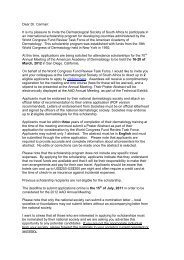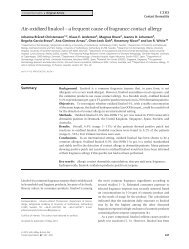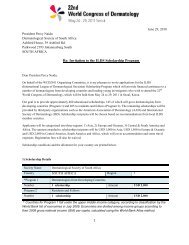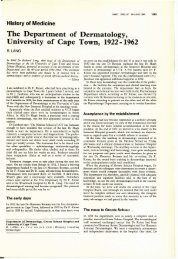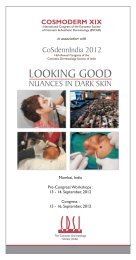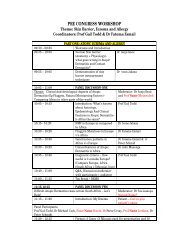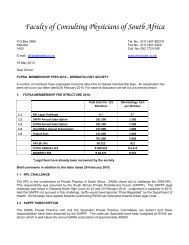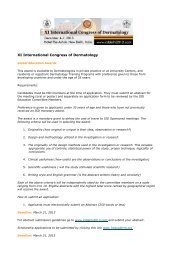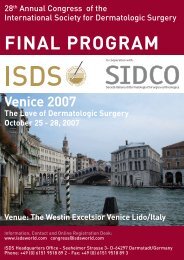Guidelines on the Management of Atopic Dermatitis ... - Dermatology
Guidelines on the Management of Atopic Dermatitis ... - Dermatology
Guidelines on the Management of Atopic Dermatitis ... - Dermatology
You also want an ePaper? Increase the reach of your titles
YUMPU automatically turns print PDFs into web optimized ePapers that Google loves.
Bathing practices [1+; A]<br />
Although salt has been used for centuries for treating skin diseases – including dermatitis –<br />
according to a systematic review 5 <strong>the</strong>re is little evidence to support <strong>the</strong> use <strong>of</strong> salt baths for<br />
treating atopic dermatitis. C<strong>on</strong>trary to this practice, hard water has been thought to play a<br />
role in triggering atopic dermatitis. In a randomised c<strong>on</strong>trolled study d<strong>on</strong>e in <strong>the</strong> United<br />
Kingdom, <strong>the</strong>re were no benefits dem<strong>on</strong>strated when i<strong>on</strong> exchange water s<strong>of</strong>teners were<br />
used. 6 These s<strong>of</strong>teners removed predominantly calcium, but not o<strong>the</strong>r c<strong>on</strong>taminants.<br />
The use <strong>of</strong> emollients is a cornerst<strong>on</strong>e <strong>of</strong> atopic dermatitis management, but in a systematic<br />
review <strong>of</strong> randomised c<strong>on</strong>trolled studies, Tarr et al reported little evidence for <strong>the</strong> additi<strong>on</strong> <strong>of</strong><br />
emollients to <strong>the</strong> bath water. 7<br />
Infecti<strong>on</strong>s are accepted as triggers for atopic dermatitis and have been implicated as <strong>the</strong><br />
cause in those with poor c<strong>on</strong>trol. Previous reviews have shown no benefit 5 and an updated<br />
Cochrane systematic review c<strong>on</strong>firmed lack <strong>of</strong> benefit for <strong>the</strong> use <strong>of</strong> bath antiseptics for<br />
infected or n<strong>on</strong>-infected atopic dermatitis patients. 8<br />
Fur<strong>the</strong>r study is required to determine <strong>the</strong> efficacy <strong>of</strong> various cleansers used in bathing, <strong>the</strong><br />
role <strong>of</strong> bathing as a steroid-sparing modality, and <strong>the</strong> optimal durati<strong>on</strong> <strong>of</strong> bathing. Emollients<br />
applied during or after bathing provide a surface lipid film retarding evaporative water loss<br />
from <strong>the</strong> epidermis.<br />
Table 5: The current recommendati<strong>on</strong>s for bathing:<br />
<br />
<br />
<br />
<br />
<br />
<br />
Regular bathing to hydrate <strong>the</strong> skin and debride crust – useful for most patients for<br />
both cleansing and hydrating <strong>the</strong> skin;<br />
Ba<strong>the</strong> <strong>on</strong>ce daily for several minutes in warm (not hot) water;<br />
Use a moisturising cleanser;<br />
Avoid antibacterial cleansers (may lead to bacterial resistance);<br />
After bathing, pat dry; and<br />
Emollients should be applied immediately after bathing.<br />
Antiseptics and antimicrobials [1+; A]<br />
Although sec<strong>on</strong>dary infecti<strong>on</strong> and col<strong>on</strong>isati<strong>on</strong> <strong>of</strong> damaged skin by bacteria is<br />
understandable, <strong>the</strong> role <strong>of</strong> bacteria in <strong>the</strong> pathogenesis <strong>of</strong> atopic dermatitis is not clear. 9<br />
Evidence for <strong>the</strong> regular use <strong>of</strong> antimicrobial and antiseptic agents in <strong>the</strong> c<strong>on</strong>trol <strong>of</strong><br />
uninfected dermatitis has been reported in a systematic review 5 <strong>of</strong> trials that included<br />
children, adolescents and adults. There was little evidence to support <strong>the</strong> use <strong>of</strong> antiseptics<br />
in ei<strong>the</strong>r bath water or if applied directly to <strong>the</strong> skin. The intermittent use <strong>of</strong> short-term<br />
mupirocin was <strong>of</strong> benefit for relapsing atopic dermatitis that was not overtly infected, but<br />
<strong>the</strong>re is c<strong>on</strong>cern for emerging resistant organisms. There were no randomised c<strong>on</strong>trol trials<br />
supporting <strong>the</strong> use <strong>of</strong> oral antibiotics.<br />
No benefits for <strong>the</strong> regular use <strong>of</strong> topical antifungals in additi<strong>on</strong> to topical steroids were found<br />
for 60 adult patients with head and neck involvement, although yeast col<strong>on</strong>isati<strong>on</strong> fell<br />
significantly.<br />
In a more recent review <strong>of</strong> <strong>the</strong> subject <strong>of</strong> antimicrobial use in atopic dermatitis c<strong>on</strong>trol, no<br />
benefit when used as a topical agent or bath additive was found. 8



